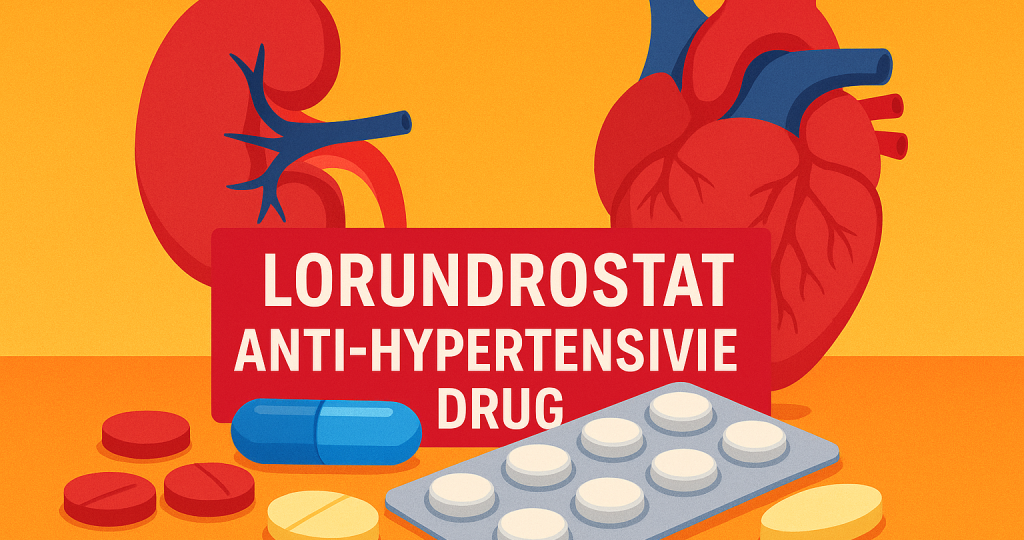03 July 2025
Category: Clinical Trials I Cardiovascular Medicine I
Antihypertensive Drugs
Written and Reviewed By:
Vikas Londhe, MPharm

Lorundrostat (MLS 101) is an oral drug that blocks the production of aldosterone, a hormone that can raise blood pressure. It works by specifically targeting and inhibiting an enzyme called CYP11B2 (aldosterone synthase), which is responsible for making aldosterone. This is important because high aldosterone levels are found in about 30% of people with high blood pressure and in most patients with treatment-resistant hypertension. Lorundrostat is designed to reduce aldosterone without significantly affecting cortisol, another important hormone.
The Launch-HTN Trial Design
The Launch-HTN trial was a multicenter, global Phase 3 randomized, double-blind, placebo-controlled study designed to evaluate the efficacy and safety of Lorundrostat, an oral aldosterone synthase inhibitor, in patients with uncontrolled or treatment-resistant hypertension. The study enrolled 1,083 adults with a mean age of 61.6 years, all of whom were receiving 2 to 5 antihypertensive medications, yet continued to exhibit elevated blood pressure. Out of these, 432 participants (39.9%) were taking 2 prescribed antihypertensive medications, and 651 (60.1%) participants were taking 3 or more. The trial was conducted across 159 sites in 13 countries between November 2023 and January 2025. The trial randomized patients into three arms: lorundrostat 50 mg once daily for 12 weeks, lorundrostat 50 mg once daily with optional titration to 100 mg at week 6, and placebo for 12 weeks. The primary endpoint was the change in automated office systolic blood pressure (AOBP) at week 6.
Results
Results demonstrated a statistically significant reduction in systolic BP with lorundrostat 50 mg (−16.9 mmHg) compared to placebo (−7.9 mmHg), with an adjusted mean difference of −9.1 mmHg. By week 12, the BP reduction persisted, reaching −19.0 mmHg in the lorindostat group, with a placebo-adjusted difference of −11.7 mmHg. The treatment effect was consistent across key subgroups, including age, sex, race, BMI, and number of baseline medications. In terms of safety, lorundrostat was well tolerated.
Safety
There were mild, reversible increases in potassium levels and slight reductions in sodium, without evidence of cortisol suppression. Confirmed hyperkalemia (K⁺ > 6.0 mmol/L) occurred in 0.6% of the 50 mg group and 1.1% in the titration group, versus 0.4% in the placebo group. Serious treatment-emergent adverse events (TEAEs) occurred in fewer than 3% of participants across all groups, and discontinuations due to side effects were rare, with only 0.37% of patients withdrawing due to hyperkalemia. These findings suggest that lorundrostat provides a significant and durable reduction in blood pressure with a favorable safety profile in difficult-to-treat hypertensive populations.
Mechanism
Lorundrostat is a new type of drug that lowers blood pressure by blocking an enzyme called aldosterone synthase (CYP11B2). This enzyme is responsible for producing aldosterone, a hormone that increases blood pressure by causing the body to retain salt and water. In many patients with uncontrolled or treatment-resistant hypertension, aldosterone levels remain high despite taking multiple medications. By specifically inhibiting CYP11B2, lorundrostat reduces aldosterone production without affecting cortisol levels, helping to safely lower blood pressure at its hormonal source.
Previous Supporting Data
The Target-HTN Phase 2 trial, which was an earlier study, showed that lorundrostat significantly lowered systolic blood pressure by around 14 mmHg over 8 weeks in patients who had low renin levels, a group likely to have aldosterone-driven hypertension. These promising findings laid the groundwork for the larger Phase 3 Launch-HTN study.
Additionally, the Advanced-HTN trial, published in the New England Journal of Medicine (NEJM), provided further support. It confirmed that lorundrostat could offer consistent and meaningful blood pressure reductions even in complex, difficult-to-treat populations. Together, these trials show that lorundrostat targets a key hormonal cause of high blood pressure and could become a valuable option for patients who don’t respond well to standard therapies.
Forward Thinking
After the strong results from the Launch-HTN and Advance-HTN trials, Mineralys Therapeutics plans to apply for FDA approval for a New Drug Application for lorundrostat as a new treatment for high blood pressure. At the same time, new research is underway to see how lorundrostat works in patients with chronic kidney disease (CKD); this study is called Explore-CKD. The top-line results of the phase 2 study of this trial showed positive results evaluating the safety and efficacy of 25 mg of lorundrostat in subjects with hypertension and comorbid CKD. Since high aldosterone levels can also affect the kidneys, researchers want to see if lorundrostat can offer benefits beyond lowering blood pressure. In the future, lorundrostat may also be tested in combination with other types of medications, such as SGLT2 inhibitors, which are used to protect the heart and kidneys. These studies could help expand the role of lorundrostat in treating both high blood pressure and related conditions.
References
Manish Saxena, Luke Laffin, Claudio Borghi, et al, Lorundrostat in Participants With Uncontrolled Hypertension and Treatment-Resistant Hypertension, JAMA, Published Online: June 30, 2025, doi: 10.1001/jama.2025.9413
Efficacy and Safety of Lorundrostat in Subjects with Uncontrolled and Resistant Hypertension, ClinicalTrials.gov ID NCT06153693, https://www.clinicaltrials.gov/study/NCT06153693?id=NCT06153693&rank=1
Laffin LJ, Rodman D, Luther JM, Target-HTN Investigators, et al., Aldosterone Synthase Inhibition With Lorundrostat for Uncontrolled Hypertension: The Target-HTN Randomized Clinical Trial. JAMA. 2023 Sep 26;330(12):1140-1150. Doi: 10.1001/jama.2023.16029. PMID: 37690061; PMCID: PMC10493865.
Laffin LJ, Kopjar B, Melgaard C, Advance-HTN Investigators, et al., Lorundrostat Efficacy and Safety in Patients with Uncontrolled Hypertension. N Engl J Med. 2025 May 8;392(18):1813-1823. doi: 10.1056/NEJMoa2501440. Epub 2025 Apr 23. PMID: 40267417.
Mineralys Therapeutics Announces Positive Topline Results from Phase 2 Explore-CKD Trial of Lorundrostat for the Treatment of Hypertension in Subjects with CKD and Albuminuria, Mineralys, June 17 2025, https://ir.mineralystx.com/news-events/press-releases/detail/73/mineralys-therapeutics-announces-positive-topline-results
